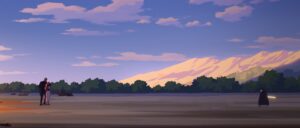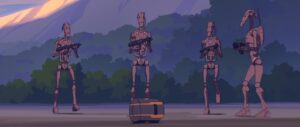If you enjoy what you read below – we hope you’ll join us to read the full Visions article and the rest of the issue by subscribing to Backstory Magazine!
Backstory was given the opportunity to exclusively interview the filmmakers behind four of the groundbreaking shorts featured in Star Wars Visions. Below, THE VILLAGE BRIDE director/co-writer Hitoshi Haga speaks about his pensive, moving short. (Note: All answers were given in Japanese and translated to English.)
By Danny Munso
Helmed by Hitoshi Haga and produced by studio Kinema Citrus, “The Village Bride” celebrates the Force in ways even the feature films and television series often fail to capture. Everything is a battle in Star Wars, but as this short reminds us, the Force itself can be a powerful way to connect with nature and our surroundings. Haga is a massive Star Wars fan so he understands that fact better than many, which is why the Force takes center stage in his film. “The Jedi had deviated from their true purpose, which was partly why the Jedi High Council failed and [the galaxy] was taken over by the Empire,” he says of Lucas’ prequel trilogy. “But in Episode IV, Luke Skywalker gains the victory not in the lightsaber battle but by using his mind’s eye instead of mechanical controls. And in Episode VI he wins by throwing away his lightsaber. The important thing is not the lightsaber battle or the universal battle. I wanted to show that the spirit is key.”

The story follows a Jedi named F and an explorer named Valco, who come to the aid of a village being held hostage by a band of raiders using old Battle Droids to do their bidding. Haru — daughter of the village chief — is preparing to wed her fiancé, Asu, and plans to surrender herself to the raiders the next day as collateral for keeping the town safe. But Haru’s sister Saku and other villagers want to fight for their freedom. The film opens with a serene sequence that sees Haru and Asu tapping into the Force as they engage in mountain worship, something practiced in the ancient Japanese religion Shugendō. “Japan is often shown in foreign productions as being very flat, but actually it is a country full of mountains and many different cultures,” Haga says. “I realized I could use a marriage ceremony to introduce the mountain culture, which would be presented in a sad story rather than the celebratory feasts often conveyed in Japan.”
Because the short presents nature in such a beautiful and positive light, the presence of Battle Droids calls to mind one of the climactic scenes from Lucas’ The Phantom Menace, where those same type of droids fight and slaughter the native Gungins on Naboo in a scene Lucas not so subtly uses as a metaphor for the destruction of nature in our real world. Haga doesn’t use that scene as an overt reference for his own story; rather, he sees one of the messages of “The Village Bride” to be that we as people should be living in harmony with nature. “It’s not just that nature should be protected, it’s about giving thanks to nature and taking good things from nature,” he says. “A tree is taken from the mountain to build a house, and then a seedling is planted. In spring, lots of people come [to Japan] to see the blossom of the many cherry trees planted alongside the rivers. People enjoy it, but [their presence] is also important to river management because they tread down on the embankments.”

It’s clear Haga is a Star Wars encyclopedia, having been obsessed with the franchise since he saw the first film as a junior high student when it was released in Japan in 1978. What followed was a lifelong fandom that included buying toys — both as a child and an adult — and using the series as an inspiration for his career as a filmmaker. So it’s not a surprise that Haga had another of Lucas’ prequels — Attack of the Clones — in mind while creating the character of F. Knowing F’s history was a necessity for the filmmakers as they plotted how she would react to the situation in which she finds herself in “The Village Bride,” even if very few of the specific details actually end up onscreen. “She lost her master at the Battle of Geonosis, and she herself was injured by Dooku’s blade,” Haga says. “While recuperating from her injury, the battle spread even further, and she started to wonder what a Jedi is. Having lost her master and having lost her pride and self-confidence because she was injured by a Sith, she began to wonder about the Jedi and her own identity. She set out on her journey with all these doubts in her mind, and that’s when Order 66 came through and her view of the future became even more opaque.” This chain of events leads to a special moment before F battles the village raiders. Ahead of the fighting, she removes her mask, revealing her face for the first time in the film. “She was moved by the commendable lives of the people of this planet and especially by the strength of Haru. F throws away her mask in order to separate from the unpleasant memories of her past and to remove the sign of the Padawan so she can rise up as a Jedi in her own way. She was ready.”
After she tosses aside the mask, there is a brief battle, and F easily cuts down her opponent and ends the raiders’ assault. And yet it’s a wrap that almost didn’t happen. Haga’s original plan was for the short to end right before the confrontation, as F ignites her lightsaber blade. “I thought it would be easy to imagine what happens next,” he says. “The injured Padawan would understand her own purpose and rise up. However, I thought viewers might not accept that, so we brought it to a proper conclusion.” In a unique visual twist, Haga had the film briefly cut to black as F makes the fatal blow with her lightsaber. “Rather than just depict the action, I wanted to symbolically depict the event that occurs along with F’s incredible speed.” He points out that there were other benefits to the brief cutaway as well: “If there were lots of blood, there would be a restriction on the rating.”
Read the rest of our VISIONS coverage:
The Duel interview
Tatooine Rhapsody interview
The Elder interview
Producers interview
Star Wars Visions is streaming on Disney+ now
Subscribing to Backstory gives you access to our entire catalog of back issues with tons of past Star Wars coverage including in-depth interviews with Dave Filoni and Rian Johnson, coverage of animated series like Rebels and Resistance, interviews with Marvel comic writers Jason Aaron and Kieron Gillen, and features with The High Republic architects Cavan Scott and Daniel Jose Older.
You can use coupon code: SAVE5 to take $5 off your subscription and get instant access! All you need to do is click HERE to subscribe!
There’s plenty more to explore in Backstory Magazine issue 45 you can see our table of contents.
Thanks for your support and stay safe and healthy!